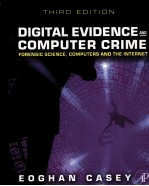图书介绍
Digital Evidence and Computer CrimePDF|Epub|txt|kindle电子书版本网盘下载

- Eoghan Casey BS MA 著
- 出版社: Academic Press
- ISBN:0123742681
- 出版时间:2011
- 标注页数:807页
- 文件大小:201MB
- 文件页数:832页
- 主题词:
PDF下载
下载说明
Digital Evidence and Computer CrimePDF格式电子书版下载
下载的文件为RAR压缩包。需要使用解压软件进行解压得到PDF格式图书。建议使用BT下载工具Free Download Manager进行下载,简称FDM(免费,没有广告,支持多平台)。本站资源全部打包为BT种子。所以需要使用专业的BT下载软件进行下载。如BitComet qBittorrent uTorrent等BT下载工具。迅雷目前由于本站不是热门资源。不推荐使用!后期资源热门了。安装了迅雷也可以迅雷进行下载!
(文件页数 要大于 标注页数,上中下等多册电子书除外)
注意:本站所有压缩包均有解压码: 点击下载压缩包解压工具
图书目录
PART 1 Digital Forensics3
CHAPTER 1 Foundations of Digital Forensics&Eoghan Casey3
1.1 Digital Evidence7
1.2 Increasing Awareness of Digital Evidence9
1.3 Digital Forensics: Past, Present, and Future10
1.4 Principles of Digital Forensics14
1.5 Challenging Aspects of Digital Evidence25
1.6 Following the Cybertrail28
1.7 Digital Forensics Research32
1.8 Summary32
CHAPTER 2 Language Of Computer Crime Investigation&Eoghan Casey35
2.1 Language of Computer Crime Investigation36
2.2 The Role of Computers in Crime39
2.3 Summary47
CHAPTER 3 Digital Evidence in the Courtroom&Eoghan Casey49
3.1 Duty of Experts51
3.2 Admissibility56
3.3 Levels of Certainty in Digital Forensics68
3.4 Direct versus Circumstantial Evidence72
3.5 Scientific Evidence73
3.6 Presenting Digital Evidence75
3.7 Summary81
CHAPTER 4 Cybercrime Law: A United States Perspective&Susan W. Brenner85
4.1 Federal Cybercrime Law85
4.2 State Cybercrime Law103
4.3 Constitutional Law107
4.4 Fourth Amendment107
4.5 Fifth Amendment and Encryption115
CHAPTER 5 Cybercrime Law: A European Perspective&Bert-Jaap Koops and Tessa Robinson123
5.1 The European and National Legal Frameworks123
5.2 Progression of Cybercrime Legislation in Europe126
5.3 Specific Cybercrime Offenses129
5.4 Computer-Integrity Crimes133
5.5 Computer-Assisted Crimes149
5.6 Content-Related Cybercrimes155
5.7 Other Offenses173
5.8 Jurisdiction178
5.9 Summary182
PART 2 Digital Investigations187
CHAPTER 6 Conducting Digital Investigations&Eoghan Casey and Bradley Schatz187
6.1 Digital Investigation Process Models187
6.2 Scaffolding for Digital Investigations197
6.3 Applying the Scientific Method in Digital Investigations201
6.4 Investigative Scenario: Security Breach220
6.5 Summary224
CHAPTER 7 Handling a Digital Crime Scene&Eoghan Casey227
7.1 Published Guidelines for Handling Digital Crime Scenes230
7.2 Fundamental Principles232
7.3 Authorization234
7.4 Preparing to Handle Digital Crime Scenes238
7.5 Surveying the Digital Crime Scene240
7.6 Preserving the Digital Crime Scene245
7.7 Summary253
CHAPTER 8 Investigative Reconstruction with Digital Evidence&Eoghan Casey and Brent E. Turvey255
8.1 Equivocal Forensic Analysis259
8.2 Victimology266
8.3 Crime Scene Characteristics268
8.4 Threshold Assessments273
8.5 Summary282
CHAPTER 9 Modus Operandi, Motive, and Technology 285&Brent E. Turvey285
9.1 Axes to Pathological Criminals and Other Unintended Consequences285
9.2 Modus Operandi287
9.3 Technology and Modus Operandi288
9.4 Motive and Technology297
9.5 Current Technologies303
9.6 Summary304
PART 3 Apprehending Offenders307
CHAPTER 10 Violent Crime and Digital Evidence&Eoghan Casey and Terrance Maguire307
10.1 The Role of Computers in Violent Crime308
10.2 Processing the Digital Crime Scene312
10.3 Investigative Reconstruction316
10.4 Conclusions321
CHAPTER 11 Digital Evidence as Alibi&Eoghan Casey323
11.1 Investigating an Alibi324
11.2 Time as Alibi326
11.3 Location as Alibi327
11.4 Summary328
CHAPTER 12 Sex Offenders on the Internet&Eoghan Casey, Monique M. Ferraro, and Michael McGrath329
12.1 Old Behaviors, New Medium332
12.2 Legal Considerations335
12.3 Identifying and Processing Digital Evidence338
12.4 Investigating Online Sexual Offenders341
12.5 Investigative Reconstruction349
12.6 Case Example: Scott Tyree357
12.7 Case Example: Peter Chapman360
12.8 Summary362
CHAPTER 13 Computer Intrusions&Eoghan Casey and Christopher Daywalt369
13.1 How Computer Intruders Operate371
13.2 Investigating Computer Intrusions377
13.3 Forensic Preservation of Volatile Data388
13.4 Post-Mortem Investigation of a Compromised System401
13.5 Investigation of Malicious Computer Programs403
13.6 Investigative Reconstruction406
13.7 Summary419
CHAPTER 14 Cyberstalking&Eoghan Casey421
14.1 How Cyberstalkers Operate423
14.2 Investigating Cyberstalking425
14.3 Cyberstalking Case Example432
14.4 Summary433
PART 4 Computers437
CHAPTER 15 Computer Basics for Digital Investigators&Eoghan Casey437
15.1 A Brief History of Computers437
15.2 Basic Operation of Computers439
15.3 Representation of Data442
15.4 Storage Media and Data Hiding447
15.5 File Systems and Location of Data450
15.6 Dealing with Password Protection and Encryption458
15.7 Summary462
CHAPTER 16 Applying Forensic Science to Computers&Eoghan Casey465
16.1 Preparation466
16.2 Survey467
16.3 Documentation470
16.4 Preservation474
16.5 Examination and Analysis485
16.6 Reconstruction499
16.7 Reporting508
16.8 Summary510
CHAPTER 17 Digital Evidence on Windows Systems&Eoghan Casey513
17.1 File Systems514
17.2 Data Recovery529
17.3 Log Files535
17.4 Registry536
17.5 Internet Traces538
17.6 Program Analysis547
17.7 Summary548
CHAPTER 18 Digital Evidence on UNIX Systems&Eoghan Casey551
18.1 UNIX Evidence Acquisition Boot Disk552
18.2 File Systems552
18.3 Overview of Digital Evidence Processing Tools557
18.4 Data Recovery565
18.5 Log Files574
18.6 File System Traces575
18.7 Internet Traces579
18.8 Summary585
CHAPTER 19 Digital Evidence on Macintosh Systems&Eoghan Casey587
19.1 File Systems587
19.2 Overview of Digital Evidence Processing Tools590
19.3 Data Recovery591
19.4 File System Traces592
19.5 Internet Traces597
19.6 Summary602
CHAPTER 20 Digital Evidence on Mobile Devices&Eoghan Casey and Benjamin Turnbull This chapter appears online at http://www.elsevierdirect.com/companion.jsp?ISBN=9780123742681602
PART 5 Network Forensics607
CHAPTER 21 Network Basics for Digital Investigators&Eoghan Casey and Benjamin Turnbull607
21.1 A Brief History of Computer Networks608
21.2 Technical Overview of Networks609
21.3 Network Technologies613
21.4 Connecting Networks Using Internet Protocols619
21.5 Summary631
CHAPTER 22 Applying Forensic Science to Networks&Eoghan Casey633
22.1 Preparation and Authorization634
22.2 Identification640
22.3 Documentation, Collection, and Preservation646
22.4 Filtering and Data Reduction651
22.5 Class/Individual Characteristics and Evaluation of Source653
22.6 Evidence Recovery657
22.7 Investigative Reconstruction659
22.8 Reporting Results667
22.9 Summary668
CHAPTER 23 Digital Evidence on the Internet&Eoghan Casey671
23.1 Role of the Internet in Criminal Investigations671
23.2 Internet Services: Legitimate versus Criminal Uses672
23.3 Using the Internet as an Investigative Tool685
23.4 Online Anonymity and Self-Protection691
23.5 E-mail Forgery and Tracking699
23.6 Usenet Forgery and Tracking703
23.7 Searching and Tracking on IRC706
23.8 Summary711
CHAPTER 24 Digital Evidence on Physical and Data-Link Layers&Eoghan Casey713
24.1 Ethernet714
24.2 Linking the Data-Link and Network Layers: Encapsulation716
24.3 Ethernet versus ATM Networks721
24.4 Documentation, Collection, and Preservation722
24.5 Analysis Tools and Techniques727
24.6 Summary736
CHAPTER 25 Digital Evidence at the Network and Transport Layers&Eoghan Casey737
25.1 TCP/IP738
25.2 Setting up a Network750
25.3 TCP/IP-Related Digital Evidence754
25.4 Summary769
CASE INDEX771
NAME INDEX773
SUBJECT INDEX775